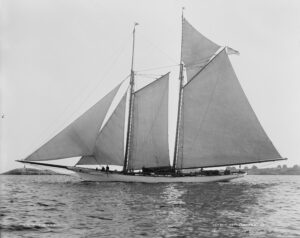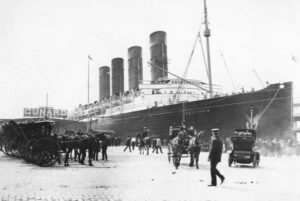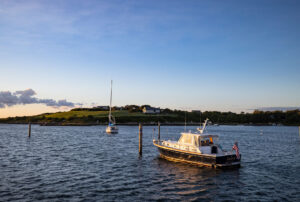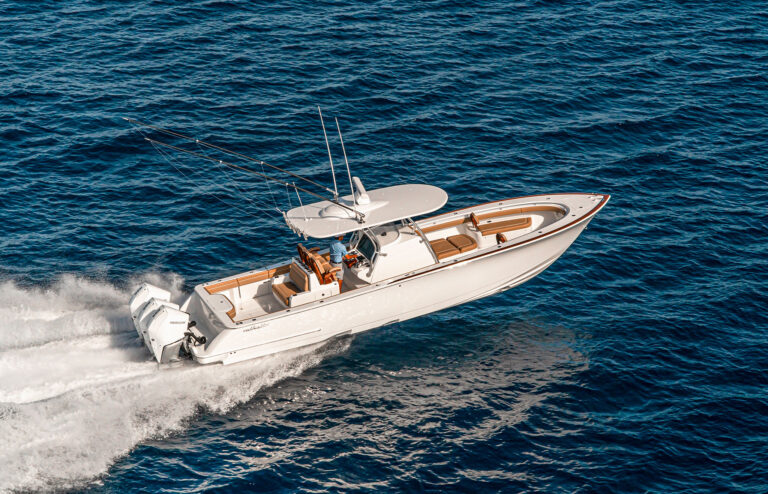When three factors conspire, it makes for a hell-ride through a notorious inlet
I grew up in Southern California, which is surely the most benign boating environment in the United States. Thanks to the region’s perfect weather, desert-like topography and a generally placid Pacific, the boating there usually ranges from serene to soporific.

Reaching my home port of San Diego from the ocean was remarkably easy. If I was headed to the main harbor, the entrance was wide, deep and protected from anything but direct southern swells. The Navy’s biggest carriers pass in and out of there with ease and without affecting other vessels. If I was headed to the anchorage in Mission Bay, north of the city, I’d enter via a much smaller, man-made inlet flanked by rock jetties and open to westerly swells. Yet thanks to the general lack of severe storms, it was rarely much of a challenge.
In 1980 I left this Eden-like nautical playground to be as near as I could to the Bahamas and still reside on U.S. soil. Looking at a map I saw that Jupiter, Fla., was the closest port — just 48 miles to West End — so there I went. That was the extent of my research. It never occurred to me to delve into the subject of inlets, and I soon found out that was a mistake. The one in my new hometown turned out to be infamous — quirky, deceptive, unpredictable and dangerous. I quickly learned that imprudent boaters had died attempting to transit it, something virtually unheard of in Southern California.
Nevertheless, I became an enthusiastic and frequent boater. I fished nearly every day and cruised to the Bahamas about once a month, so I got pretty good at reading Jupiter Inlet. But the steady stream of horror stories that swirled around the local watering holes ensured that I never got too confident and never took the inlet for granted. I knew all too well that thanks to the vagaries of wind, tide and sporadic dredging, including one instance in which a dredge pipe broke and left the channel an unnavigable maze, I was facing an inlet in which the conditions were always changing.
So before departing I made sure to take proper precautions, such as monitoring multiple weather reports — especially regarding wind direction and speed, and tides — and planning my transits to be outbound early in the morning, when the water and wind were calm, and be back well before dusk, when the sun was still high enough to read the water. And yet I nearly became one of the Jupiter Inlet’s casualties.
Cascading difficulties
One thing I’ve learned over many years of boating is that most serious situations afloat often result not from a single catastrophic event but from a series of small, pesky problems that seem inconsequential and build upon each other to create an emergency. That’s what happened on this day.
Two buddies and I had left at dawn for a day of fishing in the Gulf Stream. Heading into a beautiful pink sunrise, our transit of the inlet was uneventful. The first sign of trouble — a misfiring outboard — cropped up about midday. The symptoms included hesitation when we accelerated and a roughness at trolling speed that disappeared at planing speed. Both were annoying but not of sufficient concern to make us consider ending what had developed into a day of good fishing.
Ironically, the good fishing turned out to be another contributing factor. We were killing ’em, so we stayed out longer than we normally did and were back at the inlet nearly two hours later than usual, with the sun nearly on the horizon and right in our eyes.
A third issue: In early afternoon the winds shifted from southwesterly at 7 to 10 knots to easterly, gusting to 20 knots. A low-pressure cell apparently had materialized out of nowhere because it hadn’t appeared on any of the forecasts I regularly monitored. All of these pesky nuisances were in our minds as the big red Jupiter lighthouse emerged from the late-day haze.
We knew that because of the wind shift our normal strategy of approaching from the south while paralleling the shore wouldn’t work, but we couldn’t get a good read on what would. We hung back and waited for other boats to try their luck and see how their approach strategies fared, but there were no other boats. It seemed that everyone was already inside. So after 20 minutes, our patience at an end and the light now fading, we decided to edge in to get a closer look.
Three pairs of eyes were riveted on the inlet, and as you might expect, three conclusions resulted from what we saw. Approach strategies were proposed and debated in the dusky light. No more than 150 yards off the beach and still unable to see much of anything, we were embroiled in a heated discussion about the most prudent course, which included scrapping the whole thing and running south to Palm Beach inlet. No one was focused on the water right ahead of us.
And just like that, we were in the breakers. We didn’t hear the portentous roar, and we didn’t see the white water on the tops of breaking swells. We just felt the boat being pushed forward, and instantly we all knew what it meant.

Instinctively I jammed the throttle down into reverse, but the engine only coughed and spat, eating up precious seconds as we slid farther toward disaster. For me, everything suddenly shifted into slow motion as I felt the stern lift. I knew this was it. We were headed down the face of a wave and in all likelihood would bury the bow and probably pitchpole. It looked as if we were going for a swim.
Realizing it was too late to back out even if the engine caught, in desperation I did the only thing I could think of: I jammed the throttle forward. This time the engine miraculously caught, without hesitation, and we shot forward down the face of the wave and into I knew not what. It was a very short, very terrifying ride, but somehow our bow managed to stay out of the soup.
I remember looking over the side and seeing the blur of the sandbar as we shot over it and the beach rapidly approaching. I put the wheel hard over, and with seemingly just inches to spare we avoided the sand and were in the channel. The whole thing could not have taken more than 20 seconds, but to me it had felt like an hour. No one spoke a word as we entered the inlet and passed the familiar red lighthouse.
A sober analysis
How had three experienced boaters gotten themselves into such precarious straits? When we could finally talk, about a half-hour later, we asked ourselves that. We agreed that one mistake was failing to have someone keep an eye on the water ahead, no matter what. Indeed, it seemed inconceivable in retrospect that none of us had realized we’d breached the breaker line.
Another error was failing to fully appreciate the implications of the wind shift. We should have clearly recognized that a wind blowing directly into the inlet would dramatically change the dynamics of navigating it. Yet another mistake was staying out so long past the time when we knew we’d have good visibility, and not reflecting on how important visibility would be to a safe passage on this day — three small errors, none of which on its own was critical but when added together left us facing essentially an alien inlet.

After having seen this inlet in a wide variety of conditions and acquiring as much local knowledge as I could absorb, I’d thought I understood just how different and dangerous it could be. But after this near miss, I knew I was a rank novice and always will be. From that day forward I’ve not only had a newfound respect for this and all East Coast inlets, but I also realize that you never see the same inlet twice. Conditions are always changing, and if you’re going to be safe, your attitude and strategy have to change, as well.
And I’ve learned that you can never ignore the little things because when you’re at sea and trying to get home safely, everything is important.
Capt. Richard Thiel is editor-at-large for Power & Motoryacht magazine.
See related articles:
February 2013 issue










